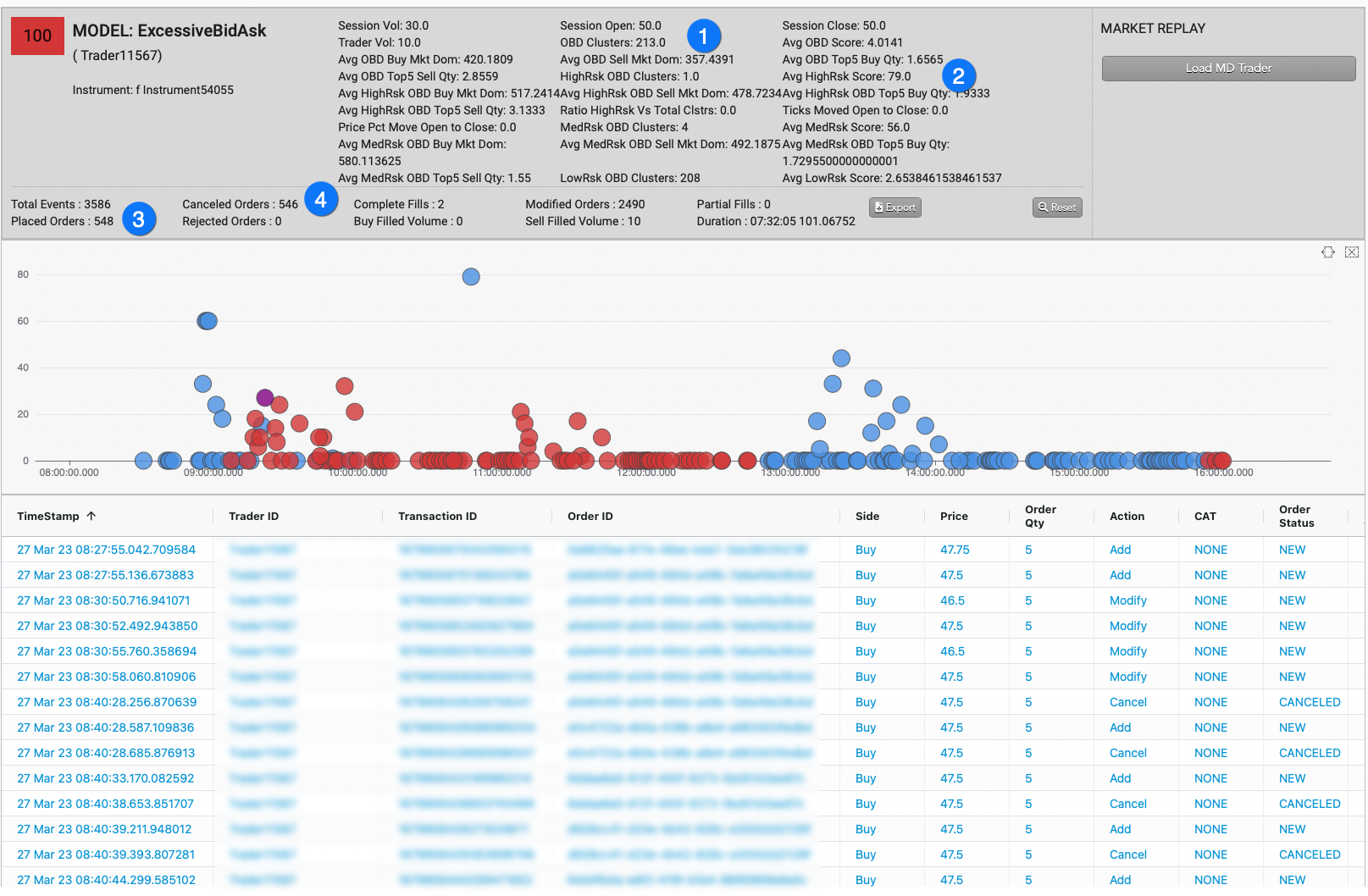Trading Behaviors Models
Excessive Bid/Ask
The Excessive Bid/Ask model looks for when a single trader's submitted orders make up the majority of the bid/ask volume of an instrument at different times during a trading session. The Excessive Bid/Ask model in TT Trade Surveillance uses the frequency and severity of Order Book Dominance (OBD) clusters generated for a trader/instrument combination to help determine if a trader is potentially exerting control over an instrument's price by submitting a large number of bids and asks during the session.
When a single trader's orders make up a large amount of the bid/ask volume for an instrument, this may indicate control over the pricing of that instrument. The Excessive Bid/Ask model can alert your firm to this behavior, which may be an indication of potential market manipulation.
Note: The Excessive Bid/Ask model only identifies potentially suspicious trading behavior. This model does not necessarily reflect an actual rule violation.
Scoring methodology
Higher scores indicate the trading activity within a cluster is more likely to risk regulatory concern. A company's risk monitors can use these scores to prioritize resources for investing which users' trading activity poses the most regulatory risk.
Excessive Bid/Ask score interpretation
The Excessive Bid/Ask model finds instances where the trader submits a high number of bids/asks relative to the session volume.
Each cluster is assigned a risk score on a sliding scale between 0-100. This score represents the probability that Excessive Bid/Ask occurred during the duration of the cluster's trading activity.
Based on TT Trade Surveillance best practices, clusters that score over 75 are deemed to be “high risk” and should be the primary focus of users during their compliance reviews.
Excessive Bid/Ask scorecard metrics
The Scorecard Metrics section measures the following statistics related to identifying the excessive bid/ask submissions:
- Session Vol — Total volume for the trading session.
- Session Open — The instrument's opening price for the session.
- Session Close — The instrument's closing price for the session./li>
- Trader Vol — The trader's total volume.
- OBD Clusters — The number of identified order book dominance (OBD) clusters.
- Avg OBD Score — The average order book dominance (OBD) score.
- Avg OBD Buy Mkt Dom — The average order book dominance (OBD) score for the 'buy' side of the market.
- Avg OBD Sell Mkt Dom — The average order book dominance (OBD) score for the 'sell' side of the market.
- Avg OBD Top5 Buy Qty — The average quantity of the top 5 buy orders identified as order book dominant for the 'buy' side of the market.
- Avg OBD Top5 Sell Qty — The average quantity of the top 5 buy orders identified as order book dominant for the 'sell' side of the market.
- HighRsk OBD Clusters — The number of high-risk order book dominance clusters.
- Avg HighRsk Score — The average high-risk score.
- Avg HighRsk OBD Buy Mkt Dom — The average high-risk order book dominance (OBD) score for the 'buy' side of the market.
- Avg HighRsk OBD Sell Mkt Dom — The average high-risk order book dominance (OBD) score for the 'sell' side of the market.
- Avg HighRsk OBD Top5 Buy Qty — The average quantity of the top 5 buy orders identified as high-risk order book dominant for the 'buy' side of the market.
- Avg HighRsk OBD Top5 Sell Qty — The average quantity of the top 5 buy orders identified as high-risk order book dominant for the 'sell' side of the market.
- Ratio HighRsk Vs Total Clstrs — The ratio of clusters identified as high-risk to the total number of clusters.
- Ticks Moved Open to Close — The total number of ticks which the instrument's price moved between the opening and closing prices.
- Price Pct Move Open to Close — The total percentage of change between the opening and closing prices.
- MedRsk OBD Clusters —The number of medium-risk order book dominance clusters.
- Avg MedRsk Score — The average medium-risk score.
- Avg MedRsk OBD Buy Mkt Dom — The average medium-risk order book dominance (OBD) score for the 'buy' side of the market.
- Avg MedRsk OBD Sell Mkt Dom — The average medium-risk order book dominance (OBD) score for the 'sell' side of the market.
- Avg MedRsk OBD Top5 Buy Qty — The average quantity of the top 5 buy orders identified as medium-risk order book dominant for the 'buy' side of the market.
- Avg MedRsk OBD Top5 Sell Qty — The average quantity of the top 5 buy orders identified as medium-risk order book dominant for the 'sell' side of the market.
- LowRsk OBD Clusters — The number of low-risk order book dominance clusters.
- Avg LowRsk Score — The average low-risk score.
- Avg LowRsk OBD Buy Mkt Dom — The average low-risk order book dominance (OBD) score for the 'buy' side of the market.
- Avg LowRsk OBD Sell Mkt Dom — The average low-risk order book dominance (OBD) score for the 'sell' side of the market.
- Avg LowRsk OBD Top5 Buy Qty — The average quantity of the top 5 buy orders identified as low-risk order book dominant for the 'buy' side of the market.
- Avg LowRsk OBD Top5 Sell Qty — The average quantity of the top 5 buy orders identified as low-risk order book dominant for the 'sell' side of the market.
Identifying Excessive Bid/Ask
Using the Cluster Scorecard, you can view the details of the activity that triggered the excessive bid/ask score.

For example:
- The model identified a large number of OBD Clusters.
- A high value for the Avg HighRsk Score.
- A large percentage of the Placed Orders were submitted then deleted as shown by the high number of Canceled Orders.
- The Complete fills — metric is very low when compared to the total Placed Orders.